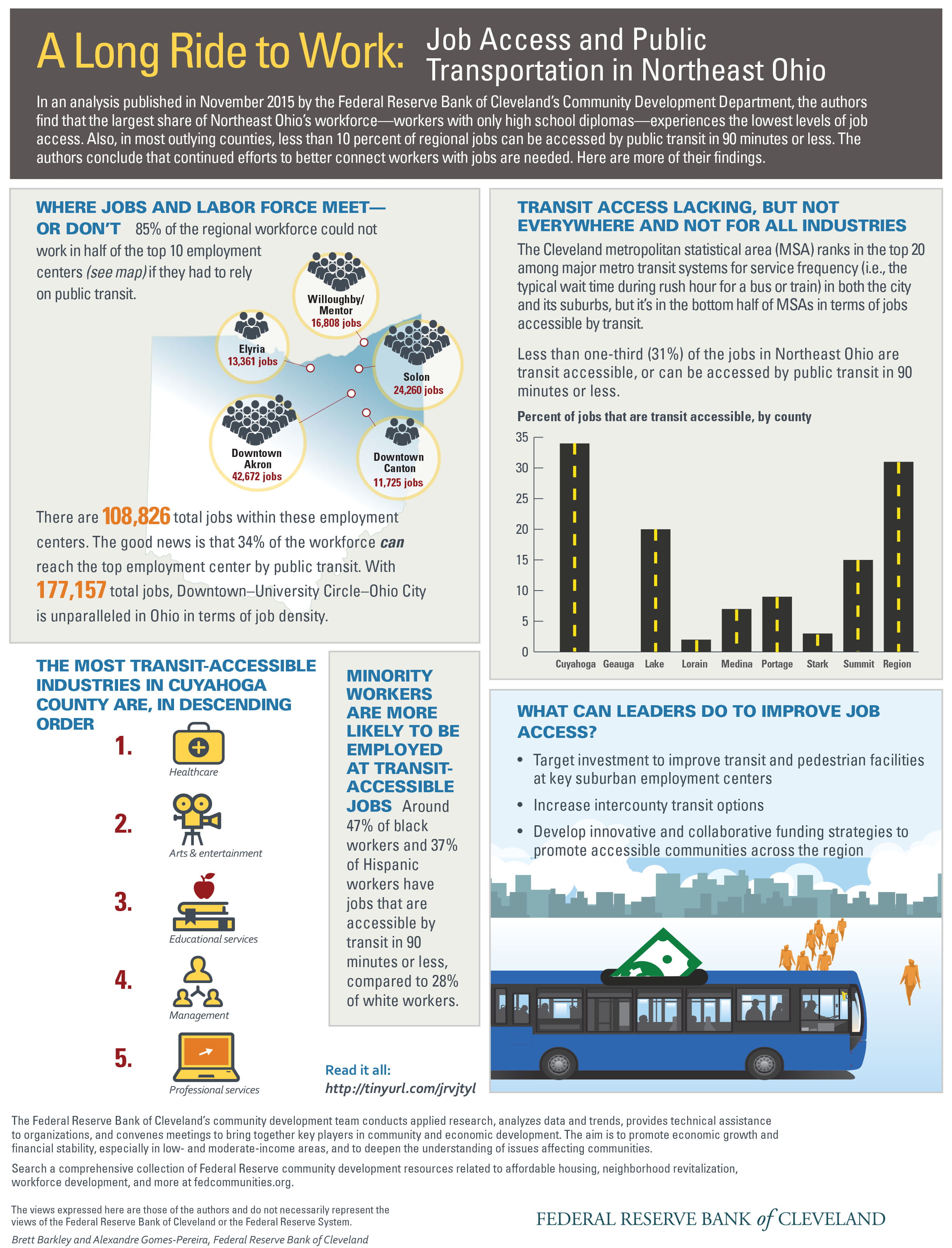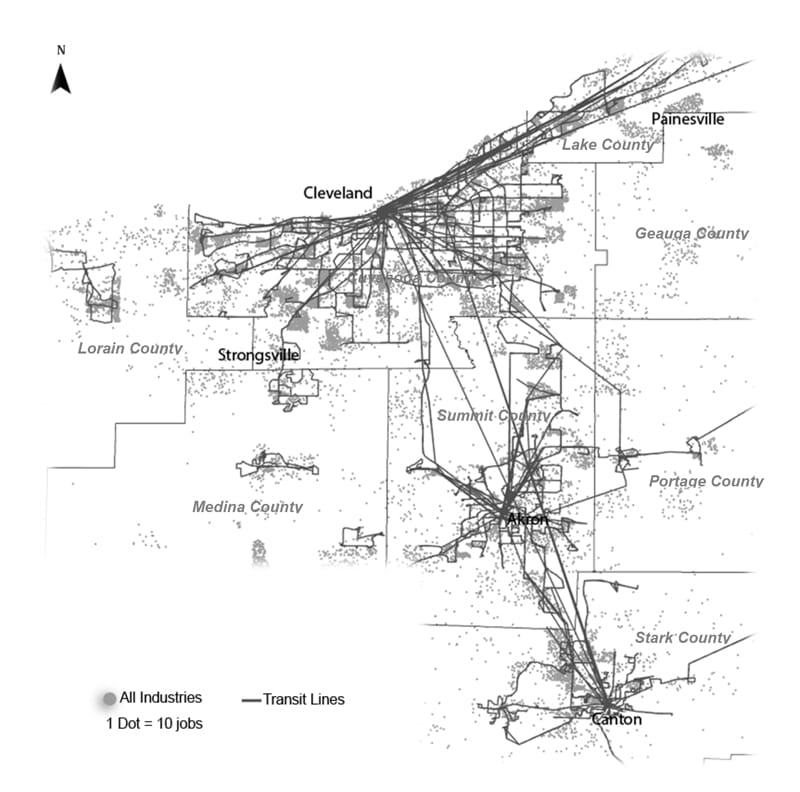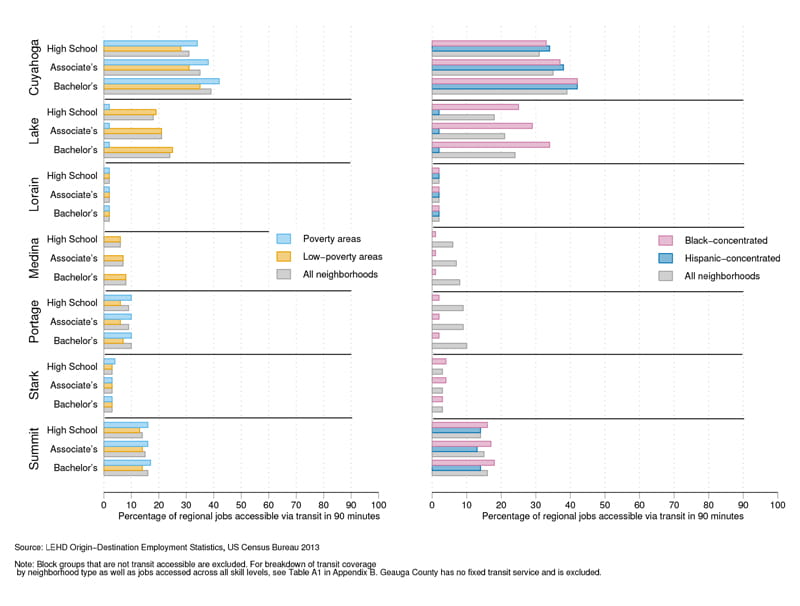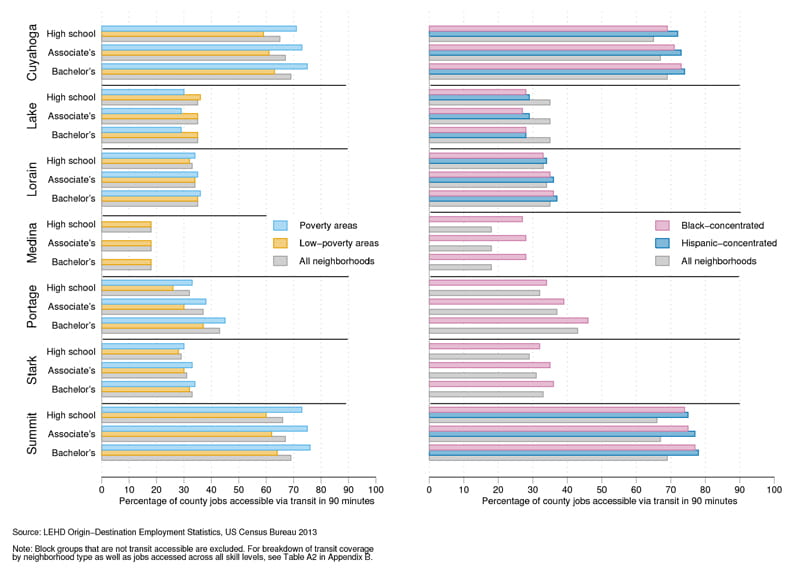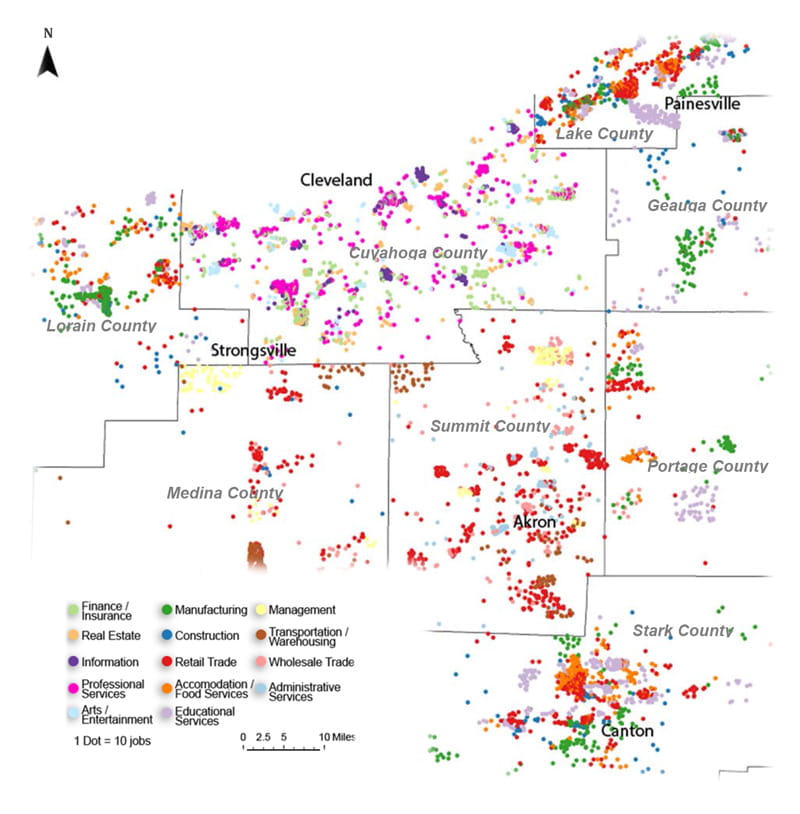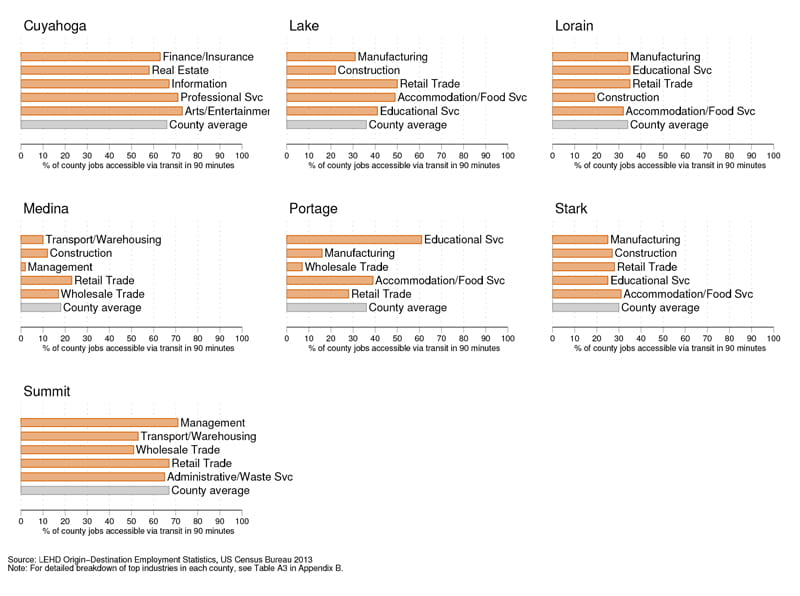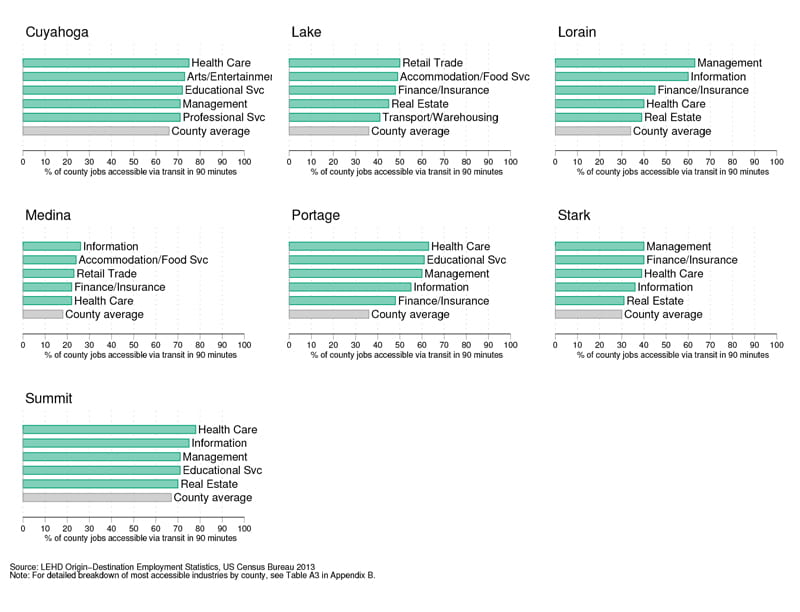- Share
A Long Ride to Work: Job Access and Public Transportation in Northeast Ohio
The daily commute is more than just an individual’s journey to work; it also represents opportunities that that person can access. Research finds that poor job accessibility tends to significantly increase the duration of joblessness among lower-paid displaced workers, especially for minorities, females, and the elderly. Longer commute distances have also been found to negatively impact the economic mobility of low-income households from one generation to the next, a finding that resonates here in northeast Ohio, which has among the lowest upward-mobility rates in the country. For many workers who rely on public transportation to get to work, then, buses and trains connect them not only to a job, but also to a livelihood—and play a role in positioning these workers and their children for future success in life.
The views expressed in this report are those of the author(s) and are not necessarily those of the Federal Reserve Bank of Cleveland or the Board of Governors of the Federal Reserve System.
Introduction
The daily commute is more than just an individual’s journey to work; it also represents opportunities that that person can access. Research finds that poor job accessibility tends to significantly increase the duration of joblessness among lower-paid displaced workers, especially for minorities, females, and the elderly. 1 Longer commute distances have also been found to negatively impact the economic mobility of low-income households from one generation to the next, a finding that resonates here in northeast Ohio, which has among the lowest upward-mobility rates in the country. 2 For many workers who rely on public transportation to get to work, then, buses and trains connect them not only to a job, but also to a livelihood—and play a role in positioning these workers and their children for future success in life.
A recent Brookings report found that the Cleveland metro area experienced the largest drop (27 percent) in the number of jobs near the average resident from 2000 to 2012 among the 96 largest metropolitan statistical areas (MSAs) in the United States. 3 This finding holds whether constricting the analysis to the city, suburbs, or entire metro and is even more pronounced in areas of high poverty (where the drop was 35 percent). The story for the Akron MSA is not much better: It ranked 84th and experienced a 14 percent drop in jobs located near the average resident. These dynamics result from a complex mix of factors including job loss, job relocation within the region, and the suburbanization of poverty.
The news is not all bad, however. Northeast Ohio performs better than the nation on a number of transit-accessibility measures. Both the Akron and Cleveland MSAs rank above average in terms of transit coverage, and the Cleveland metro ranks in the top 20 of all MSAs for service frequency in both the city and its suburbs, 4 reflecting the region’s long history of innovation in public transportation. For example, Cleveland was the first city in the US to connect its airport to direct rapid transit service. 5 And when the Greater Cleveland Rapid Transit Authority’s (GCRTA) Healthline began operation in 2008, it was viewed by some as the best bus–rapid transit project in the country. 6 Still, the Akron and Cleveland metro areas rank below average for job access via public transit, suggesting a lack of coordination between groups making decisions about economic development, transportation, housing, and workforce development. It also suggests a missed opportunity to build upon regional assets.
A recent briefing paper from the Fund For our Economic Future, an alliance of Northeast Ohio funders dedicated to advancing growth and opportunity, points to the need for local and regional civic, business and nonprofit leaders and policymakers to focus on issues of spatial access to jobs. 7 While previous research has considered job access via public transit in the Cleveland and Akron MSAs broadly, no analysis has considered how access varies across smaller geographies in the region, by industry type, or among specific sub-populations. We decided, therefore, to measure and compare levels of job access via transit in Northeast Ohio by detailed industry and skill type, with a specific focus on minority and low-income populations. 8
Our analysis of job accessibility follows in three parts. First, we present accessibility by job skill type and socioeconomic status, in order to understand not only whether low-income and minority populations can access jobs in general, but also whether they can access the jobs that most likely match their skills or education. Second, we discuss job access by industry type at the county level, considering the ability of public transportation to connect people to jobs most likely to be found in their county of residence, and rank the most-transit-accessible industries. Finally, we look at the other side of the coin, identifying the most important employment centers in the region and measuring the percent of the labor force accessible to them by transit. To provide some context for understanding our specific results, we’ll first discuss commuting patterns and the workforce in Northeast Ohio.
If interactive map fails to load, please visit the Stable URL: http://arcg.is/1kL92QC
Commuting patterns and workforce characteristics in Northeast Ohio
Jobs in Northeast Ohio are centered primarily in Cuyahoga County (49 percent), followed by Summit (18 percent) and Stark (11 percent) Counties (see Table 1). 9 Workers with a high school degree or equivalent make up the largest share of the workforce (35 percent), while those with an associate’s degree or some college, and a bachelor’s degree or higher comprise 29 percent and 24 percent of the workforce, respectively (see Table 2).
Understandably, counties with better transit coverage tend to have higher rates of workers who use transit to commute to work. 10 Only 57 percent of the population in Northeast Ohio lives in a neighborhood covered by transit. Coverage varies greatly by county, with Cuyahoga (83 percent) and Summit (63 percent) having the highest coverage and Lorain (26 percent) and Geauga (zero percent) having the lowest (Table 1). About 5 percent of workers in Cuyahoga County use public transportation to commute to work, on par with the national average, whereas workers in all other counties in the region commute to work by transit at lower rates (see Table 3). Among GCRTA riders, about 38 percent require the bus or train to get to work. 11 Given various factors, including additional wait and/or transfer times and frequent stops for other passengers, travel time to work is typically much longer for transit commuters compared to those who drive to work. Approximately 32 percent of transit commutes in Northeast Ohio take at least 60 minutes, which is slightly lower than the national rate (36 percent). 12 Most auto commutes in the region take less than 30 minutes.
Findings
1. Jobs are the least accessible for workers with only a high school degree and for positions that pay less than $1,250/month. Workers in Cuyahoga County have the highest levels of job access, but also experience the largest differences in access across skill levels.
For the first part of our analysis, we consider job access with specific regard to low-income and minority populations as well as the skill or education level needed to obtain the job accessed. Looking at the data, we find that while people living in poor and minority neighborhoods tend to have comparable or better access to regional jobs overall, they have less access to jobs that they are likely be qualified for (see Figure 2 ). 13 In fact, low-skill jobs are the least accessible across the entire population and for each neighborhood type analyzed. This dynamic is even more pronounced when focusing specifically on jobs that employ a worker with a high school degree or equivalent, workers who make up the largest share of Northeast Ohio’s workforce—and who are also more likely to not own a car and rely on public transportation. In short, the workers who would likely benefit the most from good job access via public transportation experience the lowest access.
Focusing only on county trips, we see greater disparities among neighborhoods. In Lake County to the east, for example, low-income and minority populations are able to reach just 30 percent of county jobs, whereas households in other neighborhoods tend to reach around 36 percent (see Figure 3 ). For households in areas of poverty or Hispanic-concentrated neighborhoods, county jobs are essentially the only jobs accessible to them; they have no access to jobs in other counties (see Figure 2 ). In contrast, Black-concentrated neighborhoods in Lake County have the lowest access to jobs within their county but relatively good access to jobs outside Lake County. In only the most urban counties, i.e., Cuyahoga and Summit, do low-income and minority neighborhoods tend to experience significantly better access to county jobs relative to the county population. In more suburban counties, where there is lower job access in general, vulnerable segments of the population tend to experience closer-to-average or below-average access relative to other residents.
In addition to considering the potential jobs accessible from low-income or minority-concentrated neighborhoods, we looked at the accessibility of actual jobs acquired by low-income earners and minority workers. As would be expected based on the above discussion of job access by skill type, lower-paying jobs in Northeast Ohio are more difficult to get to by public transportation (see Table 4). We also find that minority workers tend to be employed at jobs that are much more accessible by transit. Around 47 and 37 percent of all jobs employing Black and Hispanic workers, respectively, are accessible in 90 minutes or less compared to 28 percent of all jobs employing White workers—which might be the case given that Black and Hispanic workers tend to live in more transit-accessible neighborhoods, but it could also reflect the dependency of minority workers on public transit (see Table 5). Put another way, Black and Hispanic workers, especially in Cuyahoga and Lake Counties, seem to be more likely to look for and accept a job if it is near public transit relative to White workers. If this is the case, job options of minority workers are greatly limited given that less than a third of all jobs in the region are transit-accessible.
2. Residents of Cuyahoga, Lake, and Lorain Counties experience the best access to jobs in the top industries in their counties of residence, while Summit County maintains good access overall. In nearly every county, health-care jobs are among the most accessible.
In order to better understand the current location of employers in the region, we identify top industries in each county (see Figure 4 ) and analyze their accessibility to county residents. We define top industries using a location quotient measure, 14 which can be interpreted as industries most unique to each county or similarly as industries likely to be less concentrated in other parts of the region. We also rank the most-accessible industries regardless of industry size or concentration.
What we found was that workers in Cuyahoga, Lake, and Lorain Counties have above-average access to at least three out of their top five industries, relative to other industries in their county. (see Figure 5).
In Lake County, for example, jobs in educational services, retail, and accommodation/food services are more accessible than jobs in all industries, on average. In Lorain County, four out of the top five industries have access above or near the average; further, Lorain is the only county where workers in manufacturing have at least average access via public transit. However, besides health care, the most accessible industries in the county employ a low number of workers. In the remaining four counties shown in Figure 5, the majority of top industries in each county have below-average job access. Notably, while this is true for Summit County, residents there experience the highest access to county jobs overall (i.e., when considering all industries) compared to others in the region.
Cuyahoga County’s top five industries are finance/insurance, real estate, information, professional services, and arts/entertainment, industries that tend to be clustered near the urban core or in denser areas of an MSA given positive knowledge spillovers or agglomeration effects (i.e., the benefits of being located close to each other). 15 In Cuyahoga County, these industries are not located primarily in the urban core, but rather in smaller clusters or employment centers throughout the county (see Figure 4 ), some of which are well-connected to transit and some of which are not.
Jobs in the arts/entertainment, professional services, and information industries, for instance, are more accessible than jobs in the finance/insurance and real estate sectors. Cuyahoga County’s largest industry—health care—is also its most accessible, with 75 percent of health-care jobs in the county accessible in 90 minutes or less (see Figure 6 ).
3. Half of Northeast Ohio’s top 10 employment centers have access to just 15 percent or less of the regional workforce.
Finally, switching gears from residents’ access to jobs, we now consider the employers’ perspective and the percent of the labor force they have access to, focusing on the largest job centers in the region. 16 Zooming in on select geographies in this way facilitates more effective discussion of policy solutions, such as targeting investment to areas with lots of jobs but few transit connections or leveraging existing synergies in some of the region’s most dynamic districts.
The most-accessible employment centers in the region are the Downtown—University Circle—Ohio City corridor and Clark/Fulton district in the City of Cleveland, followed by commercial districts in Lakewood, Independence, and Parma, all located in Cuyahoga County (see Table 6). The Downtown—University Circle—Ohio City corridor is also the largest by far of any employment center in the region, and, in terms of job density, is unparalleled in the entire State of Ohio despite much economic hardship over the years. 17
Downtown Akron, the second-largest employment center in the region, accesses 74 percent of the labor force in Summit County, though just 15 percent of the regional labor force. Among employment centers with more than 10,000 jobs, Downtown Canton (Stark County), Elyria (Lorain County), Willoughby/Mentor (Lake County), and Solon (Cuyahoga County) are the least accessible—each accesses 12 percent or less of the regional labor force and, with the exception of Willoughby/Mentor, less than 30 percent of the labor forces in their respective counties.
Consistent with findings discussed in the first section, employment centers with higher concentrations of low-skill jobs tend to be less accessible. This dynamic is present in most counties, with the cities of Downtown Canton, Elyria, Medina, and Solon having the unfortunate combination of high concentrations of low-skill jobs and limited access by public transit. Large numbers of accessible low-skill jobs exist in the region’s two main urban job centers—Downtown Cleveland–University Circle–Ohio City and Downtown Akron—but an equal amount falls outside of these centers, largely out of reach for low-skill workers dependent on bus or train to get to work.
Policy Implications
Job access is a critical component of employment. Whether we’re talking about the share of jobs accessible via transit by the average resident or the share of the labor force accessible from major job centers, the key question is, does the existing transit network effectively link jobs with the region’s workers? Two distinct factors need to be considered: 1) whether the average resident in the region lives near viable transit options, and 2) whether jobs in a particular industry tend to be located within reach of the transit system.
Effective policy solutions to address job access will require engagement of a diverse set of public and private actors that influence economic development, transportation, housing, and workforce development decisions. The findings of this report, as well as previous studies in Northeast Ohio related to this topic, 18 provide evidence that continued efforts to better connect workers with jobs throughout the region are needed and can help guide conversations among these stakeholders as to where to focus such efforts. Though far from exhaustive, the following are key takeaways that should be considered moving forward.
-
Across the region we consistently find that low-skill and low-paying jobs are the hardest to get to. This is particularly concerning since more than a third of Northeast Ohio’s workforce has just a high school degree or equivalent. Most regional jobs requiring a bachelor’s degree or more are located in one of the two main urban job centers. Employment opportunities for low-skill jobs tend to be more dispersed in smaller suburban job centers throughout the region. Targeted strategies and investment are needed to better connect these areas to potential workers, focusing on the largest suburban employment centers with the highest concentration of low-skill jobs. This will require innovative thinking given barriers common to large corporate campuses or office complexes in suburban areas, which make access by transit harder but which can be overcome with improvements to transit and pedestrian facilities or services such as business-sponsored circulator routes to accommodate “last mile” travel.
-
Large suburban job centers could also likely benefit from increased inter-county transit options connecting workers in outerlying counties to jobs just across county lines. Such inter-county transit services should be in addition to, not in place of, current express commuter buses, which provide direct service from outerlying counties to downtown Cleveland or Akron. In fact, additional express commuter buses may also be beneficial. While such routes sometimes exceed the 90-minute threshold—e.g., in the case of Stark County’s new commuter bus to downtown Cleveland—differences in the shares of jobs in the region accessible from various counties suggest these services can play a significant role in improving job accessibility. This is most evident in Lorain County, home to the largest share of Cuyahoga County’s workforce outside of Cuyahoga County itself. 19 The proximity of Lorain and Lake Counties to Cleveland and its inner-ring suburbs would suggest similar levels of job accessibility, but the lack of commuter bus services from Lorain County translates into much lower shares of regional jobs accessed.
-
County and regional agencies should continue to use state and federal programmable funds at their disposal to encourage such service expansion and transportation improvements, but with this caveat: where appropriate, emphasize collaborative uses of funds that include multiple municipalities or partners. 20 New ways of financing such improvements should also be explored, such as the increasing role of Community Development Financial Institutions (CDFIs) in transit-related investments. With help of CDFIs, multiple metro areas across the US have recently established region-wide transit-oriented development (TOD) funds to help promote and establish more accessible communities. 21 These funds, leveraged from public, private, and nonprofit partners, provide developers with flexible, affordable capital to purchase property in close proximity to transit for development or preservation of affordable housing or to promote access to important services such as fresh foods, health care, job training centers, and child care. Funds could also be used for transit improvements themselves. While the metro areas to date that have established TOD funds are strong markets like Minneapolis, Boston, Denver, and Seattle, parts of Northeast Ohio such as the City of Cleveland and Cuyahoga County boast comparable public transportation systems in terms of coverage and service frequency. 22 Moreover, many of these metros established their TOD funds in the face of ever-increasing job sprawl in order to stem the tide of such unsustainable development patterns. Therefore, sprawl should not be an excuse for why such policy solutions might not work, but rather a reason for why they are needed. It may be necessary to start small, as in the case of Denver, by focusing on the urban core and areas that are the most viable for TOD before expanding the policy to other parts of the region. Though a weak market, Northeast Ohio is home to strong CDFIs and philanthropic institutions that are necessary to make such outside-the-box solutions work.
-
Implementation of equitable TOD strategies should leverage affordable housing funding streams, such as the Low-Income Housing Tax Credit (LIHTC). The complementary use of LIHTCs has been important for the success of existing TOD funds, but when developers are unable to secure credits, implementation is affected. State housing finance agencies, which typically allocate credits, should continue to refine their allocation criteria to incentivize the development and preservation of affordable housing near transit and in a manner that, as much as possible, strengthens local and regional funding strategies. The Affirmatively Furthering Fair Housing (AFFH) rule passed by the Department of Housing and Urban Development in July 2015 could help in this regard; 23 it provides clearer guidelines as to how local, regional, and state agencies are to meet fair housing goals and empowers increased coordination across levels of government to better ensure that funding streams map to local needs. Agencies will be required, for example, to assess the location of affordable housing in terms of proximity to employment and public transportation. In Northeast Ohio, complementary efforts could include those discussed above: targeted investment to improve transit and pedestrian facilities at key suburban employment centers, increased inter-county transit options, and collaborative funding strategies to promote accessible communities across the region.
Conclusion
Job access is about equitable development, but it is about economic competitiveness, too. Jobs in Northeast Ohio are least accessible for the people who need them most—reason enough to put job access on the radar of regional policymakers and business leaders. However, consumer preferences are also changing. Millennials and baby boomers alike want more accessible communities, whether that means a workplace within reach of transit or downsizing from large suburban homes to areas where amenities important to them are just a walk away. 24 Metros that provide these opportunities will likely have a leg up in the 21st century economy. Job access is certainly not the only component for regional economic success, but it is an important one and should be a focus in Northeast Ohio moving forward.
- Fredrik Andersson and John C. Haltiwanger and Mark J. Kutzbach, “Job Displacement and the Duration of Joblessness: The Role of Spatial Mismatch,” Census Bureau Center for Economic Studies research paper 11-30R 2014. Return
- Raj Chetty and Nathaniel Hendren, “The Impacts of Neighborhoods on Intergenerational Mobility: Childhood Exposure Effects and County-Level Estimates,” Harvard University, Cambridge, MA: 2015; and Raj Chetty, Patrick Kline, and Emmanual Saez, “Where is the Land of Opportunity? The Geography of Intergenerational Mobility in the United States,” Quarterly Journal of Economics, 2014, 129(4), 1553-1623. Return
- Elizabeth Kneebone and Natalie Holmes, “The growing distance between people and jobs in metropolitan America,” Brookings, Washington D.C.: 2015. Return
- Adie Tomer, Elizabeth Kneebone, Robert Puentas, and Alan Berube, “Missed Opportunity: Transit and Jobs in Metropolitan America,” Brookings, Washington D.C.: 2011. Return
- John Neff and Matthew Dickens, “2013 Public Transportation Fact Book,” American Public Transportation Association, Washington D.C.: 2013. Return
- Angie Schmitt, “The Ridiculous Politics That Slow Down America’s Best BRT Route,” StreetsBlog USA: 2014. Return
- Emily Garr Pacetti, Cecile Murray, and Sam Hartman, “The Geography of Jobs: The increasing distance between jobs and workers in Northeast Ohio,” Fund For Our Economic Future, Cleveland, OH: 2015. Return
- For the purposes of this study, Northeast Ohio is defined as the eight counties with at least 3,000 commuters to the main job center in the region (i.e., Cuyahoga County). Counties include Cuyahoga, Geauga, Lake, Lorain, Medina, Portage, Stark, and Summit. Return
- See also Figure 1. Return
- Transit coverage is defined as the share of the population living in a census block that has at least one transit stop within 3/4 mile of its geographic center. Return
- Woodrum, Amanda, “Committing to Ohio’s Commuters: Transit and Ohio’s New Energy Economy,” Policy Matters Ohio, Cleveland, OH: 2009. Return
- Steven E. Polzin and Alan E. Pisarski, “Commuting in America 2013: The National Report on Commuting Patterns and Trends,” American Association of State Highway and Transportation Officials, Washington D.C.: 2015. Return
- We use the Census Bureau’s definition of a "poverty area" as any census tract or block numbering area where at least 20 percent of residents live below the poverty level. As defined by the Department of Housing and Urban Development, a minority-concentrated neighborhood is a census geography where the population share of a minority group is 20 percentage points higher than the regional average. Return
- This indicates the share of jobs in a particular industry accessible by residents in a 90-minutes-or-shorter transit ride. Top five industries in each county are categorized according to their location quotient, which measures the share of workers employed in an industry across the county relative to other counties in the region (the county is used as the local area and Northeast Ohio as the reference area). Return
- Edward Glaeser, “Demand for Density? Functions of the City in the 21st Century,” Brookings Review, Washington D.C.: 2000. Return
- This indicates the share of workers accessible by the employers in a 90-minutes-or-shorter transit ride. We use top employment centers identified by the Center for Neighborhood Technology’s BUILT in Cleveland study, which identified adjacent census block groups in the region with employment density above seven jobs per acre. See “Broadening Urban Investment to Leverage Transit (BUILT) in Cleveland,” Center for Neighborhood Technology, Chicago, IL: 2011. Return
- “Broadening Urban Investment to Leverage Transit (BUILT) in Cleveland,” Center for Neighborhood Technology, Chicago, IL: 2011. Return
- See Emily Garr Pacetti, Cecile Murray, and Sam Hartman, “The Geography of Jobs: The increasing distance between jobs and workers in Northeast Ohio,” Fund For Our Economic Future, Cleveland, OH: 2015 and “Broadening Urban Investment to Leverage Transit (BUILT) in Cleveland,” Center for Neighborhood Technology, Chicago, IL: 2011. Return
- U.S. Census Bureau. Residence County to Workplace Flows for the United States, 2006-2010. Return
- Such agencies may include county community development, economic development, and planning agencies as well as the region’s metropolitan planning organizations: Northeast Ohio Areawide Coordinating Agency (NOACA), Akron Metropolitan Area Transportation Study, and Stark County Area Transportation Study. For one example of such collaborative funding strategies, see Snyderman, Robin and Beth Dever, “Building capacity through collaboration in Chicago’s suburbs,” Brookings Metropolitan Policy Program, Washington DC: 2015. Return
- See John Moon, “Building a National Equitable TOD Network,” Federal Reserve Bank of San Francisco, San Francisco, CA: 2015 and also the Federal Reserve Bank of St. Louis’ Connecting Communities seminar on “Equitable Transit-Oriented Development: Increasing Connectivity and Mobility for All,” accessed via https://bsr.stlouisfed.org/connectingcommunities/. Return
- See Adie Tomer et al., “Missed Opportunity: Transit and Jobs in Metropolitan America,” Brookings, Washington D.C.: 2011. Return
- See Affirmatively Furthering Fair Housing (AFFH) Final Rule, accessed via https://www.hudexchange.info/programs/affh/. Return
- More than half of Americans say they would prefer to live in a place where they do not need to use a car very often. Such preferences are strongest among millennials and baby boomers. See “America in 2015: A ULI Survey of Views on Housing, Transportation, and Community,” Urban Land Institute, Washington D.C.: 2015. Return



